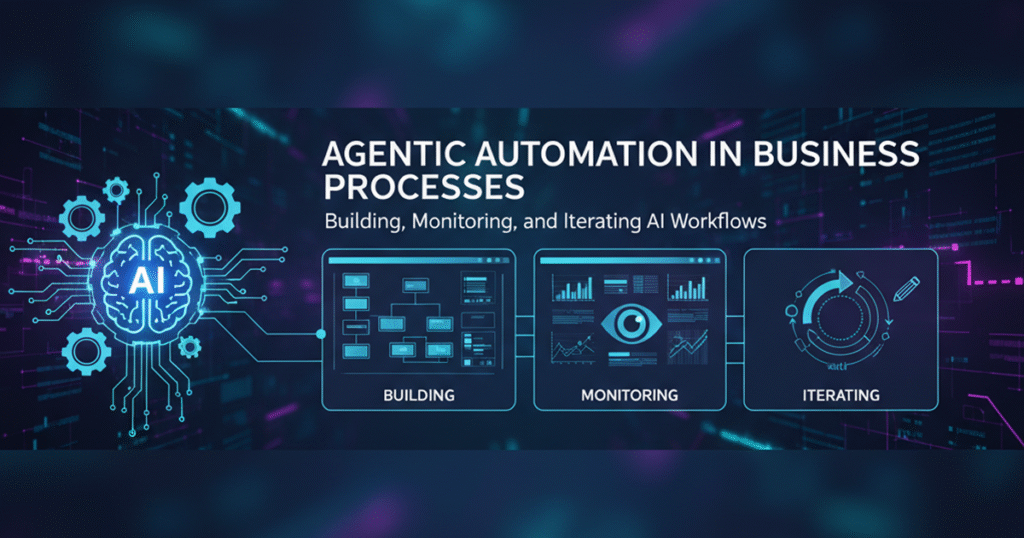The rise of Agentic Automation is changing how businesses design, manage, and scale their processes. Unlike traditional automation that follows pre-set rules, agentic systems use AI-driven agents that can make decisions, adapt to changes, and continuously improve workflows. For enterprises looking to stay competitive, adopting this new generation of automation is no longer optional—it’s a necessity.
In this blog, we’ll explore how agentic automation empowers organizations through AI workflows, business process automation, workflow monitoring, iterative AI processes, and enterprise AI automation.

What Is Agentic Automation?
At its core, Agentic Automation leverages intelligent agents powered by AI and machine learning. These agents can perform tasks, collaborate with other systems, and even learn from past actions to optimize future outcomes.
Unlike rule-based bots that break down when conditions change, agentic systems thrive in dynamic environments. This makes them ideal for cloud-native, enterprise-scale processes where flexibility and intelligence are crucial.
AI Workflows: The Backbone of Digital Transformation
Every business process—whether in finance, HR, supply chain, or customer service—can be represented as a workflow. AI workflows take this concept further by embedding intelligence into every step.
For example:
In customer support, AI workflows route tickets to the right department, suggest responses, and escalate only when human intervention is truly needed.
In finance, AI agents can reconcile transactions, detect fraud patterns, and flag anomalies in real time.
By implementing AI workflows, businesses gain speed, efficiency, and reduced human error—while also freeing employees to focus on strategic tasks.
Business Process Automation: Beyond Rules and Scripts
Traditional business process automation was limited to repetitive, rules-based tasks. While effective for structured processes, it struggled with exceptions or complex decision-making.
Agentic Automation takes business process automation to the next level by:
Understanding context rather than just executing steps.
Adapting workflows when new information becomes available.
Collaborating with humans when critical decisions are needed.
This shift enables organizations to move from static workflows to living, intelligent systems that evolve with the business.
Workflow Monitoring: Keeping an Eye on Every Process
No automation is complete without workflow monitoring. In the age of digital enterprises, visibility into ongoing processes is critical for ensuring efficiency, compliance, and security.
Agentic systems continuously monitor workflows by:
Tracking execution in real time.
Detecting bottlenecks and inefficiencies.
Alerting teams when anomalies occur.
Automatically suggesting optimizations.
With proactive workflow monitoring, businesses can not only prevent issues before they escalate but also uncover new opportunities for process improvement.
Iterative AI Processes: Learning and Improving Over Time
One of the biggest advantages of agentic automation is its ability to support iterative AI processes. Unlike static systems, these processes don’t remain fixed—they learn, adapt, and refine.
For example:
A supply chain AI might initially optimize delivery routes.
Over time, it learns from traffic data, seasonal demand, and customer feedback.
The workflow evolves to make smarter, faster, and more cost-efficient decisions.
This iterative approach ensures that workflows remain relevant even as business needs change.
Enterprise AI Automation: Scaling Intelligence Across the Organization
Adopting enterprise AI automation means going beyond isolated projects. It’s about embedding intelligent agents into every layer of the enterprise.
Key benefits include:
Consistency: Standardized workflows across departments.
Scalability: Automated processes can handle higher volumes without adding manual overhead.
Compliance: Automated monitoring ensures regulatory requirements are consistently met.
Resilience: AI-driven processes adapt to disruptions, reducing downtime.
With enterprise AI automation, organizations gain a future-ready foundation for innovation and growth.
Why Agentic Automation Matters Now
In today’s competitive landscape, businesses must do more than just digitize—they must intelligently automate. Agentic automation delivers:
Speed in executing complex workflows.
Agility in adapting to new challenges.
Intelligence in decision-making.
Sustainability through iterative improvements.
By combining AI workflows, business process automation, workflow monitoring, iterative AI processes, and enterprise AI automation, organizations can move beyond efficiency gains to create smarter, adaptive business ecosystems.
Final Thoughts
and evolves, enterprises can unlock new levels of performance and innovation.
👉 At Brigita, we specialize in building and scaling agentic automation solutions that integrate seamlessly into your enterprise. From designing AI workflows to deploying enterprise AI automation with monitoring and iterative improvements, we help you transform business processes for long-term success.
Learn more and contact us today at Brigita GenAI Solutions.
Search
Categories

Author
-
Nandhakumar is a passionate Graphic Designer who transforms ideas into powerful visual stories that inform, inspire, and persuade. As an emerging creative professional, he is eager to grow from the ground up—constantly learning new tools, experimenting with fresh concepts, and refining his craft. For him, challenges spark creativity, with music serving as a trusted source of inspiration that helps ideas flow and designs come to life. Outside of design, Nandhakumar is a cinema lover who enjoys exploring stories on the big screen, finding both inspiration and relaxation through films.
